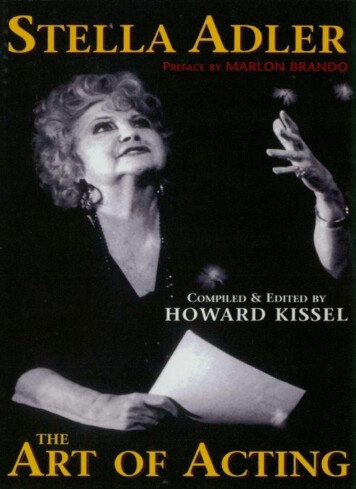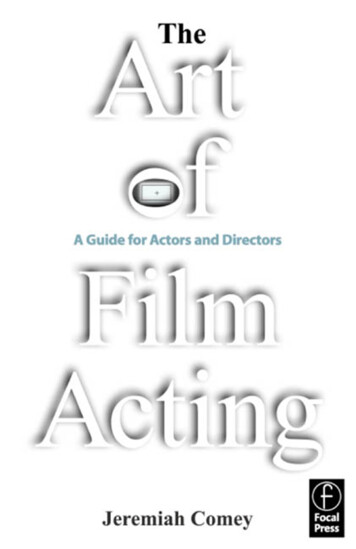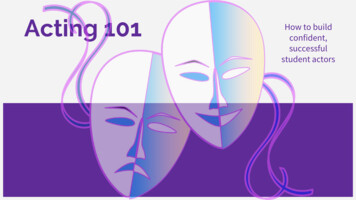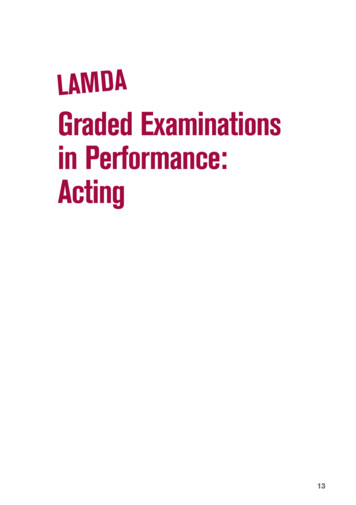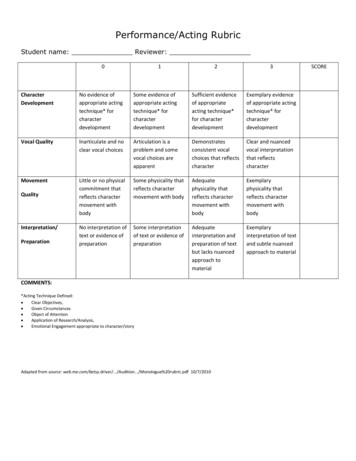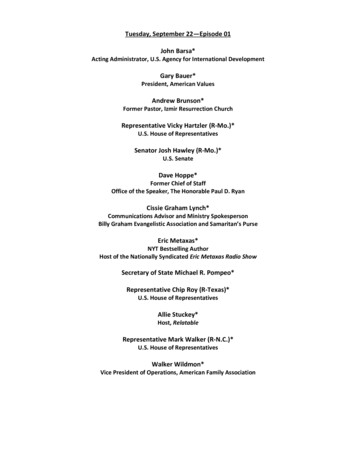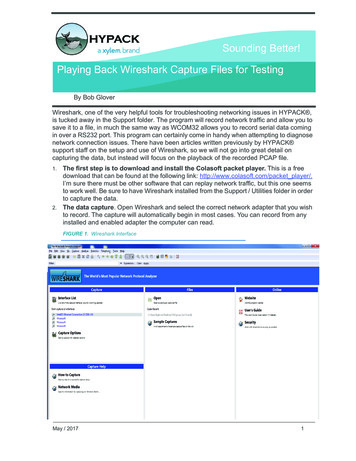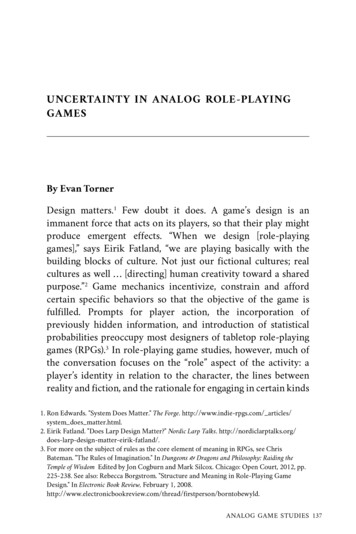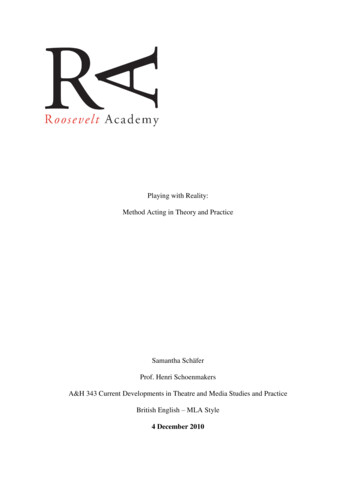
Transcription
Playing with Reality:Method Acting in Theory and PracticeSamantha SchäferProf. Henri SchoenmakersA&H 343 Current Developments in Theatre and Media Studies and PracticeBritish English – MLA Style4 December 2010
Schäfer 1TABLE OF CONTENTSIntroduction . 2I. Theory and Techniques of Method Acting . 41. Stanislavsky’s System . 42. The Different Approaches to Method Acting . 93. Historical Development of the Actors Studio . 144. In-depth Analysis of Method Acting . 255. Method Acting in Practice . 36II. The Relationship between Shakespeare and the Method . 426. Statement of the Issue . 427. Methodology . 448. Results . 479. Discussion . 50Conclusion . 54Works Cited . 57Appendices . 58
Schäfer 2IntroductionLee Strasberg once said: “Human beings are affected unconsciously by a variety ofimpulses going on inside them: to express one of them can lead to a moment of reality onstage. How ticklish, sensitive, wonderful our impulses are: how can we make the bird dowhat we want?” (qtd. in Hirsch 131). He further emphasised: “Acting is the most human ofthe art.” Method acting involves an actor personally in the art of acting, creating a linkbetween the fictional character and the real human being in order to express reality on stage.This humanity on stage is what transforms a play into reality before the eyes of the audience.While this aim is universally agreed upon, the means by which it is reached vary. Thechasm between theory and practice is even further widened by scholarly misinterpretations:The original Russian work, which provides the basis of the Method, is often only dealt within translations, and those in turn are often shortened. Method acting, as presented by scholars,does not necessarily have to coincide completely with the actual approach by actors. After all,despite there being a common method to it, acting is a highly individual art, of which someaspects cannot be generalised easily.Such problems will be dealt with in this paper, which proceeds along two differenttypes of research. The first and considerably larger part deals with the theoretical frameworkof Method acting. The development of Method acting and its underlying theory is analysedon the basis of secondary sources, i.e. scholarly interpretations. It also includes a historicalapproach to the foundations of the Actors Studio, the school that is mainly credited withteaching Method acting nowadays. The theoretical approach is followed by an analysisaccording to primary sources, i.e. the Method as it is understood by students of Method actingand the way professional Method actors implement the theory in their daily work. Themethodology in the first part is thus based on theoretical research using secondary sources
Schäfer 3and, later, primary, i.e. more subjective sources. It is guided by the main research question ofthe paper: What are the characteristics of Method acting and its relationship to Stanislavsky’soriginal System as characterised by secondary sources, and how is Method acting actuallyapproached in practice?The second part is based on empirical research which deals with a sub-questionresulting from the main research: How is Method acting approached in regard toShakespearean plays, and is it suitable for performance based on poetic, formal language? Inother words, this part analyses the relationship of a script’s use of language on the overallcredibility of the performance and determines whether or not the Method’s aim can befulfilled regardless of this particular language. This is especially significant for the practicalapproach to Method acting. The tradition of the Actors Studio does not include Shakespearefor various reasons; however, it is questionable whether this tradition is justified. This thenrepresents the empirical part of the study, based on the theory of performance analysis in TheCambridge Introduction to Theatre Studies.
Schäfer 4Part I: Theory and Techniques of Method ActingStanislavsky’s SystemContemporary Method acting, as taught and practised by the Actors Studio, originallystems from Stanislavsky’s System. Caught in the conventions of early 19th century Russiantheatre, he longed for an entirely realistic acting style. By systemising what he saw in greatactors, he hoped to develop a method that every actor, not only the most talented ones, coulduse in order to excel at their work and in order to make the audience believe in what they seeon stage. This “scrupulous realism in performance and production design would issue achallenge to the artificial conventions that were strangling Russian theatre” (Hirsch 20) withits “[c]ommercial glossiness, theatrical fakery, [and] narcissism” (25) at the time he starteddeveloping his System. His theatrical revolution would occupy him for the rest of his life. Itgained exceeding importance after the Moscow Art Theatre was founded by Stanislavsky andNemirovich-Danchenko: “In less than a decade, and certainly by the time of the BolshevikRevolution in 1917, they had evolved into theatrical elder statesmen temporarilyovershadowed by upstarts who denounced them as dry-as-dust conservatives” (41).The Russian audience was especially susceptible to such new theatrical conventionsafter the revolution, since they “looked to the theatre for something other than entertainmentor temporary relief, wanting instead to confront, through the mirror of dramatic art, their owndeepest impulses” (49). In the uncertain and new society in post-revolutionary Russia,theatregoers thus perceived theatre as more than just pure entertainment. Stanislavsky’snewly proposed system, against the grain of theatrical conventions, fit quite well into thegeneral atmosphere of the country. The audiences were more open towards it because“Russian theatre [ ] was as polarized as Russian politics: the forces of the old and the forcesof the new faced each other behind a volley of theory and pronouncement” (47).
Schäfer 5It is difficult to put Stanislavsky’s System into exact words and there are undoubtedlymany different interpretations of it. This is partly due to the fact that Stanislavsky himself“never deemed his System or his books complete; they remain dynamic, experimentalexplorations of the unique communicative power of theatre” (Carnicke 16). However, it iscommonly agreed that Stanislavsky works on the grounds of two major assumptions.Firstly, he believes “that mind and body represent a psychological continuum” (ibid).Mind and body work together in various ways to achieve perfection. As a consequence, thebody has to function perfectly, without any tensions whatsoever, in order for the mind towork properly as well. On this basis, “[p]erformance demands a state of physical relaxation,in which the actor uses only enough muscular tension to accomplish what is necessary” (17).Secondly, he points out “that successful acting places the creative act itself in the lapsof the audience” (ibid). This suggests that it does not rely only on the actor. Instead, it is hisresponsibility to create and maintain a proper relationship with the audience by “remain[ing]essentially dynamic and improvisatory during performance.” This state of acting, which hecalls ‘experiencing’, is related to states of mind such as “‘inspiration’, ‘creative moods’, theactivation of the ‘subconscious’” and stresses the importance of the actor’s living through andfeeling the character he is portraying. This means that the actor does not only have to portraythe character, but, in order to portray him realistically, needs to actually live and experiencewhat the character is experiencing as a real person. Stanislavsky’s whole System essentiallycentres on this state of experiencing, as he considers it the most essential part of the art ofacting.The System can then be divided into two main categories: techniques to create andmaintain the state of experiencing, and techniques for character creation and work on roles.
Schäfer 6In the first category, “[t]he actor develops a theatrical sense of self by learning tocontrol the skills of concentration, imagination and communication” (18). To develop such asense of self, one first has to train those three areas.This process of concentration begins with maintaining “total mental and physicalconcentration on stage”, a state that he calls “public solitude” (ibid, emphasis in the original).This psychophysical process relies on the sharpening of the actor’s senses. Next to thephysical senses – the visual, aural, tactile, olfactory and gustatory parts – Stanislavsky alsoincludes an affective sensory aspect. Actors need to be trained to be consciously aware oftheir sensations. For this purpose, he develops a number of exercises that supposedly help anactor develop a sensory awareness and, by this, improve his concentration. Another methodto train the actor’s concentrations is called “circles of attention” (20, emphasis in the original)of varying sizes. This consists of the actor’s focusing only on the objects that can be foundwithin a specific circle that has been determined beforehand. At the early stage of theexercise, the circle of attention is small, but is expanded as the exercise progresses and theactor’s concentration improves.Imagination encompasses “an actor’s capacity to treat fictional circumstances as ifreal, to visualise the details of a character’s world specifically, and to daydream or fantasiseabout the events of the play” (ibid). Visualisation, then, is the core element of imagination.This process is trained “by strengthening inner vision” and by employing what Stanislavskycalls “the magic if” (21, emphasis in the original), a mind experiment that relies on the actor’srelationship to objects, real and imaginary. This relationship is changed by adding a differentcomponent to the object which, then, affects the direct relationship between actor and object.Communication is essential to Stanislavsky’s action theory. It is concerned with“interaction amongst scene partners and between actors and audience” (ibid). Suchinteractions are fed by words, but also by the play’s non-verbal subtext “that describes
Schäfer 7anything a character thinks or feels but does not, or cannot, put into words.” Unlike dialogue,subtext is communicated “through non-verbal means (body language, the cast of the eyes,intonations and pauses.” To train this communication, Stanislavsky emphasises theimportance of “rays of energy that carry communication” and trains actors to recognise aswell as manipulate those. Non-verbal communication is also trained using silentimprovisation, i.e. improvisations of “situations that involve naturally silent moments.” Thoseare later followed by improvisation on verbal moments.The second group of character creation is divided into techniques focusing on“imagination and intellect” (23) and techniques that “rely on physicalisation.” However, allthose can only take place after careful reading of the whole play.Imaginative and intellectual techniques involve “affective cognition and the scoring ofactions” (ibid, emphasis in the original). Affective cognition is a “cognitive analysis” thatrequires a collective approach – i.e. the play is divided up into several elements which arediscussed by the whole cast – and an individual approach, i.e. the “actors work individuallyby visualising distinct moments from their characters’ lives, thus imaginatively emphasisingwith them.” The collective approach always precedes the individual approach.Physical techniques involve “the scoring of actions” (ibid, emphasis in the original).Because physical action is the basis of a play and depicts the character’s motivation, theactors first have to learn to make a distinction “between actions and activities and [learn] toexecute them” (24). To do this, the actor has to break the play into ‘bits’, wherein “each bitembodies a single action and begins whenever the action of the scene shifts, not with theplaywright’s division of the play. For each bit, the actor first examines the givencircumstances and describes the character’s situation in an adjective.” Working with hisnotion of his psychophysical continuum, Stanislavsky assumes that emotions are the naturalconsequence of action. If an actor focuses on executing the single actions defining his
Schäfer 8character in the play, “the character’s emotions [arise] as a result.” The actor’s focus clearlyhas to lie on the actions instead of the result, the emotions. Following up on this, the actor hasto “[discover] and then [perform] the logical sequence of physical actions necessary to carryout the inner, purposeful actions of scene” (26). This sequence is called ‘score’. One needs todistinguish the score of physical actions and the score of actions: “The score of physicalactions inclu
Method acting involves an actor personally in the art of acting, creating a link between the fictional character and the real human being in order to express reality on stage. This humanity on stage is what transforms a play into reality before the eyes of the audience. While this aim is universally agreed upon, the means by which it is reached vary. The chasm between theory and practice is .

